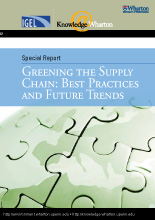Critical Issues in Greening the Supply Chain
The more corporations around the globe focus on sustainability, the more they realize that their greatest challenges and opportunities often lie outside their own offices and manufacturing plants. To make a truly significant lifecycle leap, large companies have to work on greening their supply chains.
Recognizing this, Wharton’s Initiative for Global Environmental Leadership (IGEL) devoted its 2012 annual conference to “Greening the Supply Chain: Best Business Practices and Future Trends.” Attended by noted academics and professionals, the conference covered a broad range of topics.
This special report, a collaboration between IGEL and Knowledge at Wharton, zeroes in on four of the most pressing issues in the field, using information from the conference, as well as additional interviews and research.
Managing Green Supply Chains: Best Practices and Long-term Solutions
Underlying the relatively easy steps some companies are taking to green their supply chains are a few core principles. These best practices can accomplish a great deal of good for the environment in the near term. But, sooner rather than later, executives will have to look beyond the low-hanging fruit and find long-term solutions to make companies truly sustainable.
Walking the Talk: Speed Bumps in the Road to Green
For some companies, it’s easier to write an optimistic sustainability report than it is to thoroughly green its operations and those of its suppliers. Obstacles include consumer unwillingness to pay a premium for environmentally friendly products, the complexity of modern supply chains and the huge capital investment often required. But increasingly, strong regulation, real opportunities to save money by reducing waste and the need to maintain a positive brand image are pushing corporations to thoroughly revamp their operations.
The Greening of Supply Chain Information Systems
Many of the largest and best global corporations are still using spreadsheets to handle environmental data. To make their supply chains truly sustainable, companies need information systems that merge environmental and economic data, and make the results available to all stakeholders within and outside the company. The challenge is daunting, but progress is being made on many fronts.
Greening the Supply Chain: Driving Transportation Reform
Transportation is only an estimated 4% of the global supply chain, but it’s one of the ripest areas for reform. Combining trips, switching to alternative fuels and fuel-efficient shipping, reducing wasteful product returns, and reusing material rather than sending it to landfills are just a few of the options available. Savvy companies are setting ambitious energy use and greenhouse gas reduction targets.



